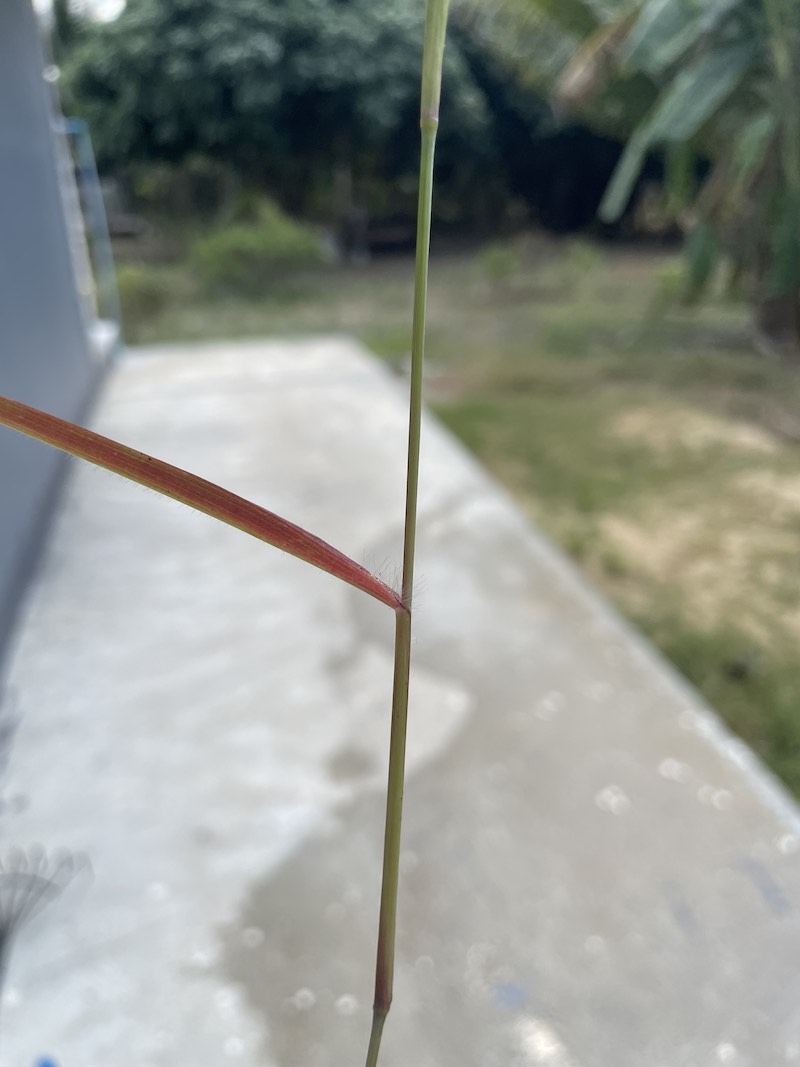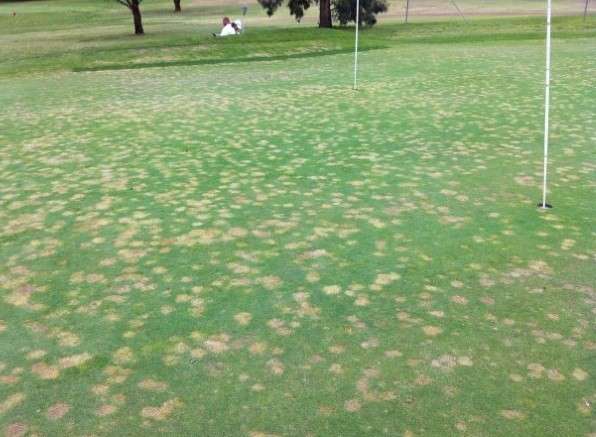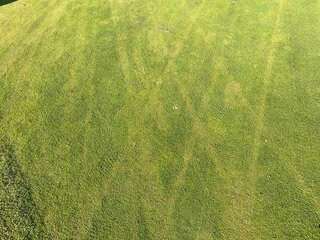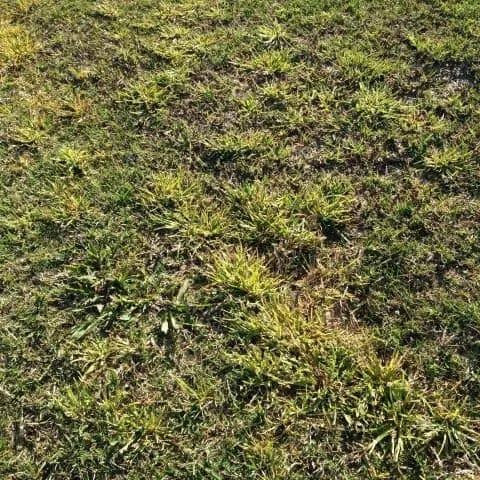This is a free guide to turf registered sulfonylurea (SU) herbicides in Australia. It discusses sufonylurea examples and how effective the sulfonylurea herbicides are as a ryegrass killer and their properties.
The turf chemical section contains all the labels and SDS sheets, and this free turf chemical manual is also useful. Throughout this article, we give examples of sulfonylurea herbicides and refer to these turf chemicals by trade names and also by their actives. At the end of this is a free sulfonylurea herbicides table showing what weeds they control.
What are the Sulfonylurea Herbicides?
The SU’s are classed as Group 2 herbicides and are used widely in the turf industry for three main reasons.
- Firstly, due to their high selectivity.
- Secondly, due to their low level of mammalian toxicity and finally
- Because of their low environmental impact.
All SU’s have the same mode of action and they act by stopping acetolactate synthase (ALS). In short, once applied to a weed the plant begins to starve and later, as new growth occurs plants die as they cannot make proteins. They basically starve to death.
There is no “best” SU herbicide and they all have a role to play in turf management.
Tips for using Sulfonylurea Herbicides.
- Since they all have the same mode of action, always rotate with other chemical groups.
- Avoid spray drift, as this reduces chance of non-target damage.
- You need to water in some SU’s after you apply them. Others work better with a spray adjuvant. So make sure that you always read the label.
- Due to an increase in the chance of turf damage do not use these within seven days of organophosphate insecticides;
- Their high specificity means that turfgrass tolerance varies. For example, you can safely use Prosedge® for sedge control in both cool- and warm-season turfgrass. In contrast, Recondo herbicide also controls sedges, but it causes damage to some cool-season grass and is a ryegrass killer.
- The blog on factors affecting herbicide performance covers this group in more detail.
Tank mixing the SU herbicides.
-
Don’t mix these with other chemicals i.e. graminicides. For example, Destro® in a tank mix with SU herbicides gives poor results;
-
These work best at a tank pH of around 7.0 so don’t mix with acidifying chemicals or fertilizers;
Getting the Best results from the SU herbicides.
-
With a high water pH, they are very mobile and can cause turf injury. For example, Tribute® herbicide and metsulfuron are 50 to 100 times more water-soluble when the water pH increases from 5 to 7. This means that ‘herbicide tracking‘ is possible for up to 20 hours after you apply them;
-
When you use these as a ryegrass killer to transition ryegrass, you get the best results when the couch is growing well and the ryegrass dies quickly. The aim when you use these as ryegrass killers, is that the couch rapidly fills in the dead areas and there is minimal disruption. So use these when the average air temperatures are 18°C or higher, and/or when average soil temperatures at a depth of 150mm are 21°C or higher. These target temperatures should ideally continue for the week following use.
-
You get the best results when weeds are actively growing. In contrast, weeds that are under stress will not take up any chemical. You can deal with this by using a methylated seed oil like Voltage MSO.
-
Despite having a short soil residual, once plants begin to grow, there can quite often be a small amount of chemical left in the soil. This can impact any reseeding work and is why there are withholding periods on many labels. However, these are not true pre emergent herbicides.
Negatives of Sulfonylurea Herbicides.
In brief, there are two major negatives of these:
- Firstly, they are all prone to herbicide resistance. Sulfonylurea resistance in Chickweed exists in the UK, so regularly rotate your chemistry.
- Secondly, all have some soil residual which impacts the success of any overseeding with sports turf seed.
Signs of Sulfonylurea Herbicide damage.
-
First, growth stops;
-
A few days later, target weed leaves wilt, crinkle and yellow;
-
Leaf margins take on a red colour and finally
-
New growth is stunted and deformed.

The Table below shows the Turf Grass tolerance to SU herbicides.
Brand name e.g | Kikuyu | Couch grass | Perennial ryegrass | Bentgrass | Tall fescue | Kentucky Bluegrass | Buffalograss | Zoysia | QLD Blue | |
Foramsulfuron | Tribute® | S | T | Not safe | I | T | S | |||
Halosulfuron | Halo-Force® 750W | Tolerant | ||||||||
Rimsulfuron | Coliseum® | S | T | Not safe | S-I | T | ||||
Trifloxysulfuron | Recondo® | S | T | Not safe | T | T | ||||
Iodosulfuron | Duke® | T | T | Not safe | T | S | ||||
Rimsulfuron + metsulfuron | Negate® | S | T | Not safe | T | T | ||||
Bispyribac-sodium | Nominee® | Tolerant | ||||||||
Sulfonylurea Herbicides for Turf.
The following are sulfonylurea examples with details of how they work and how best to use them.
Tribute herbicide® – (22.5g/L Foramsulfuron).
General: Tribute Selective herbicide® controls cool-season grasses, is a ryegrass killer and controls Crowsfoot grass in couch grass.
In the US this is sold as Revolver herbicide (Envu) where it is also has a label to control Henbit.
Tolerant Turfgrasses to Tribute Herbicide:
Apply to couchgrass (common and hybrid) and Zoysia grass. However, don’t use on Queensland Blue Couch, Centipedegrass, and cool-season grasses, such as fescue, ryegrass, bentgrass, and Kentucky Bluegrass.
Use Pattern:
- Tribute Selective herbicide® controls winter grass, crowsfoot grass, ryegrass, and non tolerant warm-season turf grasses.
- It also removes clumpy ryegrass and fescue and
- is an excellent Spring transition aid in overseeded couch. The need for SU herbicides as transition aids is negated to some degree with newer turf varieties like Breakout II however.
Overseeding Restriction:
- You can overseed with ryegrass after one week. Sprigging of couch grass should be left for two weeks after use. Foramsulfuron has a T1/2 of 1-2 days.
Usage:
- Don’t immediately water after application of Tribute herbicide.
- Allow a 2-hour window and allow Tribute herbicide to dry before traffic. This avoids damage to cool-season turfgrass due to tracking. Even then, tracking can occur after morning dew the day after treatment.
- To reduce the potential for any issues, water the morning afterwards and try and leave a 3-metre buffer around areas of creeping bentgrass.
Weeds Controlled:
- Tribute® gives great control (>90%) of many very hard-to-control cool-season grasses like winter grass, ryegrass, and clump fescue.
- It is a good post-emergent for the control of crowsfoot grass.
Prosedge® (750g/kg Halosulfuron).
General: A good example of a sulfonylurea herbicide containing this active is Prosedge herbicide. This is the only sulfonylurea example that controls yellow and purple nutsedge as well as Mullumbimby couch.
Tolerant Turfgrass: All cool and warm season grasses are tolerant.
Target weeds: In short, Prosedge herbicide is used to control sedges, and you get the best results when sedge plants are between the 3rd and 8th leaf stages. Also, with thick growth, it needs repeat applications, 6 to 10 weeks apart. Finally, use no more than 200g/Ha per season. You cannot use this as a ryegrass killer.
Overseeding Restriction: None.
Usage: Prosedge herbicide is rainfast after 3 hours, so best results occur when no rainfall or irrigation happens within 4 hours of use. Usually, after 7 – 10 days you can see the first signs of damage and the full effects are seen after 4-6 weeks. Best results are with a non-ionic surfactant such as BS1000.
Weeds Controlled: Depending on the age and size of the target, an 80 to 100% kill of yellow and purple nutsedge will occur. However, purple nutsedge is thought to be more sensitive to Prosedge® than yellow nutsedge.
Coliseum® (250g/kg Rimsulfuron).
General: This is used to control winter grass and also as a ryegrass killer in overseeded couch.
US Brand name: In the US this is sold as Tranxit herbicide (Du Pont) and has a much more extensive registration than in Australia. Weeds it controls include tall fescue, shepherd’s purse, field pansy and dollar weed (pennywort).
Tolerant Turfgrasses: Couchgrass.
Use Pattern: You can use Coliseum herbicide® on sod farms, sports fields, and golf courses. Both turf roots and leaves take up Coliseum®, so if you water it in within 1 hour, it will move the herbicide into the soil and increase its performance. If watering, take care to avoid surface runoff as Coliseum is able to move with water.
As a result, take great care when applying Coliseum® near, or on slopes that drain onto, cool-season grasses. In fact, short, frequent, irrigation cycles work best to water it in without any runoff.
Although tracking and runoff almost never result in the death of bentgrass, off-colour turf, and growth reduction will persist for 14 days, or longer, depending on weather and fertility.
Also always add a non-ionic surfactant (for example BS1000) at 250mL/100 L (0.25 % v/v) of final spray volume.
Overseeding Restriction: After you use Coliseum herbicide, you cannot overseed for 10 days as rimsulfuron has a T1/2 in the soil of 1.7 to 4.3 days.
Weeds Controlled: Coliseum herbicide provides greater than 90% control of ryegrass, fescue, and winter grass and broadleaf species such as common chickweed and spotted spurge.
Recondo® WG herbicide (100g/kg Trifloxysulfuron).
General: There are currently two examples of sulfonylurea herbicides containing trifloxysulfuron on the Australian market.
Recondo herbicide is an alternative herbicide to Monument® Liquid herbicide and is for broadleaf weed, sedge, and Winter Grass control in Couchgrass. It is also used as a transition aid as a ryegrass killer, and suppresses Kikuyu grass.
Tolerant Turfgrasses: Couchgrass is tolerant to Recondo herbicide
Overseeding Restriction: You cannot overseed for 6 weeks after you use Recondo herbicide, while you can sprig couch or seed after 4 weeks. This is an important consideration if you have limited time, for example, on multiuse stadiums.
Use Pattern: Use Recondo herbicide on golf courses, sod farms, and other non-residential sites. What’s more, on juvenile turf, delay use until there is 100% ground cover, and you have a 50mm root depth.
Use: To control hard-to-control weeds such as sedges and tall fescue, you need to make repeat applications of Recondo herbicide. Make the follow-up 4 to 6 weeks after the first application. Lastly, do not exceed an annual application total of 113g/Ha per year. Recondo herbicide is rainfast within 3 hours of use.
It is not that good to control plantains so simply add carfentrazone to the tank mix to increase the rate of kill of this weed.
Duke® herbicide (100g/kg Iodosulfuron-methyl )
In Australia, there are three examples of sulfonylurea herbicides that contain this active ingredient. These are Proforce Duke, Envu Destiny herbicide and Lonhro 100WG.
General: Duke® herbicide suppresses Winter grass and reduces bahiagrass seed head. Duke herbicide also works as a ryegrass killer and controls weeds like Bindii, Black Thistle, Cat’s Ear, Cotula, Cudweed, Guildford grass (Onion Grass), Medic, Mouse-ear Chickweed, Oxalis, White Clover, and False Onion Weed/ Fragrant False Garlic/ Onion Weed.
Tolerant Turfgrass: Use Duke herbicide on Kikuyu, buffalograss, or couch (common and hybrid couch) but NOT on Queensland Blue Couch.
Overseeding Restriction: After you use Duke herbicide allow at least six weeks between the last use before you overseed with cool season grasses like Intense perennial ryegrass.
Use Pattern: After you use this, growth slows within the first few days and chlorotic patches start to appear. Later on, shoot death occurs under good growing conditions, with death occurring 4 to 6 weeks later.
Like many SU herbicides, Duke herbicide can be transferred or ‘tracked’. So, to reduce this risk, allow at least 4 hours for uptake before watering.
Application to very dry sandy soils followed by soaking rainfall as well as to alkaline soils (soil pH >8.5) may also cause turf damage.
In short, Duke herbicide is a foliar herbicide with less activity via the soil. As a result, aim to use a water rate of 200-500 L/ha.
Use: If the tank water pH is less than 5.5 raise the water pH to 7.0 and do not mix with acidic compounds. Do not make more than one application in a season except for Bahiagrass.
Always apply with a non-ionic surfactant, for example, BS1000 or Hasten® at the label rate.
Negate® (167 g/kg Rimsulfuron and 200 g/kg Metsulfuron-methyl)
General: Negate® contains two sulfonylureas, and you use it to control winter grass, as a ryegrass killer, and to control onion grass, and certain broadleaf weeds. These include Onehunga, caustic weed, white clover, Cobblers Peg, Creeping Indigo, Creeping Oxalis, Plantain, and Daisy.
Tolerant Turfgrass: Use Negate® on common and hybrid couch, zoysia, and also Qld Blue Couch.
Overseeding Restriction: 6 weeks
Use Pattern: Both shoots and roots take up Negate and it is rainfast within 4 hours. It quickly slows weed growth after the foliage takes up the chemical. Leaves of weeds then bleach after 1-3 weeks before dying. Herbicide activity increases in warm, moist conditions; however, in cold, dry conditions, activity slows down.
Root Absorption: As Negate herbicide moves downward through the soil, plant roots are able to take up any remaining herbicide.
Use: When you use this as a ryegrass killer, with annual ryegrass it often needs a second treatment 4 to 6 weeks later.
Nominee® herbicide (100g/L Bispyribac-sodium)
The next sulfonylurea herbicide is bispyribac-sodium.
General: Unlike other examples of sulfonylurea herbicides, Nominee herbicide controls wintergrass (Poa annua) in creeping bentgrass, tall fescue, and ryegrass. It does not act as a ryegrass killer. It also inhibits winter grass seed heads.
Tolerant Turfgrasses: You can safely use this on couch, Zoysia, and Qld Blue Couch.
Overseeding Restriction: 42 days is the figure to keep in mind. You can’t seed bentgrass, perennial ryegrass or tall fescue for 42 days after use. You also can’t use Nominee® for at least 42 days after seeding creeping bentgrass, perennial ryegrass, or tall fescue.
Use Pattern:
- Nominee® is taken up by roots and then moves to the shoots.
- Don’t mix with a surfactant or crop oil as it will yellow intolerant turf;
- Nominee® claims to be slow-acting. However, the image below shows this isn’t always the case. Be aware that results can be “variable”.
- Don’t apply to turf under stress and
- If you use Nominee within twelve hours of rain, don’t irrigate or mow for 24 hours afterwards.
Research into bispyribac-sodium
- You can use Nominee® to control winter grass in creeping bentgrass at rates ranging between 60 and 140 g ha-1.
- Two applications of Nominee® on a creeping bentgrass fairway at 74 g a.i. /ha in the summer reduce Poa annua and also reduce creeping bentgrass injury.
- McCullough and Hart (2010) found the best weekly rate for Poa annua control in creeping bentgrass was 24.6 g a.i. ha−1, for up to 2 months. After two months, winter grass was reduced by 90% plus there was acceptable creeping bentgrass discoloration. However, after two months, all treatments reduced turf quality because of voids forming. Six applications reduced turf quality the most.
Nominee herbicide SDS

The Future of the Sulfonylureas Herbicides.
As these examples of sulfonylurea herbicides show, these are very useful as weed killers, and as spring transition aids to remove cool season grass from overseeded warm season turf.
All the above examples of sulfonylurea herbicides have the same mode of action.This means the issue of herbicide resistance is a problem. Weeds have naturally-occurring biotypes that are resistant to this chemical group. So if you continue to use these and do not rotate to other groups, it means that at some stage resistant weeds are likely to develop.
Table showing the weeds controlled by SU herbicides.
The sulfonylurea herbicides list below shows common broadleaf and grass weeds you can control with SU herbicides. Rather than list specific sulfonylurea examples we list them by actives.
Foramsulfuron | Halosulfuron | Rimsulfuron | Trifloxysulfuron | Iodosulfuron | |
Grass Weeds | |||||
Poa annua | E | P | E | G-E | Suppression |
summergrass spp. | Poor control | P-F | |||
fescue, clump | E | P | E | E | |
crowsfoot | G-E | Poor control | |||
Guildford grass | E | ||||
ryegrass, clump | E | P | E | E | Suppression |
ryegrass, Italian | E | P | E | E | |
Broadleaf Weeds | |||||
Bindii | G | ||||
Catsear | G | ||||
Cotula | G | ||||
Cudweed | G | ||||
chickweed, common | P | G-E | G | G | |
clover, white | P | G | |||
speedwell | E | P | P | E | |
dandelion | G-E | ||||
dichondra | P | G-E | |||
henbit | Good control | ||||
knotweed, prostrate | Poor control | ||||
Oxalis | G | ||||
plantain, buckhorn | |||||
spotted spurge | P | G-E | G-E | ||
wild violet | P |
| |||
Other Weeds | |||||
Mullumbimby Couch | E | G | G-E | G-E | |
nutsedge, purple | G-E | F | G-E | ||
nutsedge, yellow | G | F | G-E | ||
wild garlic | P | ||||
E = >90% F = 70-80% G = 80-90% P = <70% A blank space indicates that weed response is not known. | |||||
Disclaimer.
The information on this website is for general purposes only. While we try to keep it up to date and correct, we make no representations or warranties of any kind, express or implied, about the completeness, accuracy, reliability, or suitability with respect to the website or the information, products, or services, on the website for any purpose.
© 2023, Gilba Solutions Pty Ltd, All rights reserved

Jerry Spencer
Jerry has an Hons Degree in Soil Science (1988) from Newcastle Upon Tyne University. He then worked as a turf agronomist for the Sports Turf Research Institute (STRI) until 1993.
He gained a Grad Dip in Business Management from UTS in 1999. He has held a number of technical roles for companies such as Arthur Yates (Commercial Technical Manager) and Paton Fertilizers (Organic, turf specialty and controlled release fertiliser) portfolios.
In 2013 he established Gilba Solutions as independent sports turf consultants and turf agronomists. Jerry has written over 100 articles and two books on a wide range of topics such as Turf Pesticides and turfgrass Nutrition which have been published in Australia and overseas.


